Day 2 of a long weekend of tours today, which saw us heading west along the coast to Titchwell. It was a glorious day, bright and sunny, wall to wall blue skies at times, it could almost have been the summer we barely had.
We were making our way along the coast road when we spotted a large, dark bird in a stubble field alongside. There were no other cars coming, so we pulled up and had a quick look. It was a juvenile Marsh Harrier, dark chocolate brown with a paler cream head. It was pecking at the ground and clutching at the clods of earth, but didn’t appear to have caught anything. When another car came round the corner, it flew off inland.
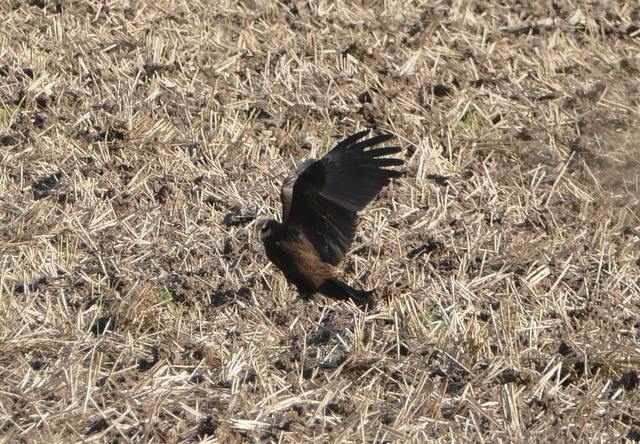 Marsh Harrier – in a stubble field by the road this morning
Marsh Harrier – in a stubble field by the road this morning
When we got to Titchwell, the main car park was already starting to fill up. However, the overflow car park was still quiet so we had a walk round, looking in all the bushes and trees which are covered in berries and apples. A flock of Long-tailed Tits flew across, calling. Several Chaffinches were feeding on the berries, as was a Blackcap. An obliging Song Thrush perched up amongst the brambles, catching the morning sun. A Comma butterfly did likewise, feeding on the blackberries.
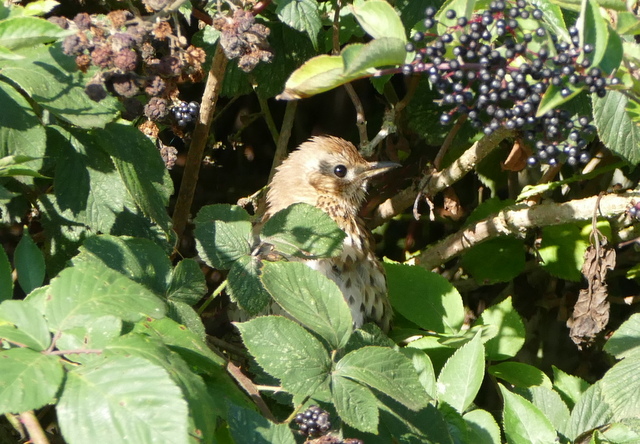 Song Thrush – catching the sun among the berries in the car park
Song Thrush – catching the sun among the berries in the car park
We went to have a look over the paddocks from the back of the car park and, while we scanned the fields we heard a falcon calling. Over the trees behind, we saw a Hobby flying in. As it approached the trees, two more Hobbys flew up from below it. We saw them grapple and drop down again out of sight. Shortly afterwards, we spotted one of them perched in one of the dead trees on the edge of the reserve. Through the scope, we could see that it was a juvenile and it was busy feeding on something, presumably food brought in by the adult we had seen.
 Hobby – juvenile feeding on prey, presumably brought in by one of its parents
Hobby – juvenile feeding on prey, presumably brought in by one of its parents
We had seen lots of Siskin flying overhead, moving along the coast, yesterday. As we walked out onto the reserve, it was clear they were still coming through, though perhaps in not such large numbers today, as a couple more small flocks flew overhead. A Redpoll flew over calling as well.
The grazing marsh pool is still largely dry, though with a few puddles from the recent rain. The Lapwings seem to like it like that, a couple of Ruff were feeding along the edge of the reeds in front of us and two Dunlin dropped in briefly as well. There were lots of birds in the reeds around the edge of the pool, mostly Reed Buntings and a Reed Warbler. We could hear several Bearded Tits calling, but when they flew we had a quick glimpse before they dropped quickly back into the reeds again. Some more Bearded Tits called behind us from the main reedbed, very close to the path, but disappeared similarly quickly. It was rather frustrating, as we had hoped to get a good look at them today.
There was a large raft of duck on the reedbed pool, so we stopped to look through them. There were lots of Common Pochard, but no sign of the Red-crested Pochard on there today, plus a Tufted Duck and a few Gadwall. We could hear more Bearded Tits calling, but couldn’t see those ones at all. A Cetti’s Warbler was similarly vocal and elusive.
We decided to try the freshmarsh instead and headed for Island Hide. We had stopped by the path to the hide to look at a Grey Plover out on the saltmarsh when we heard yet more Bearded Tits calling from the other side of the sallows. We walked a little further along the path, but these ones were not showing themselves either. We were rewarded with our first Little Stint feeding out on the mud on the freshmarsh, dwarfed by a Ringed Plover nearby.
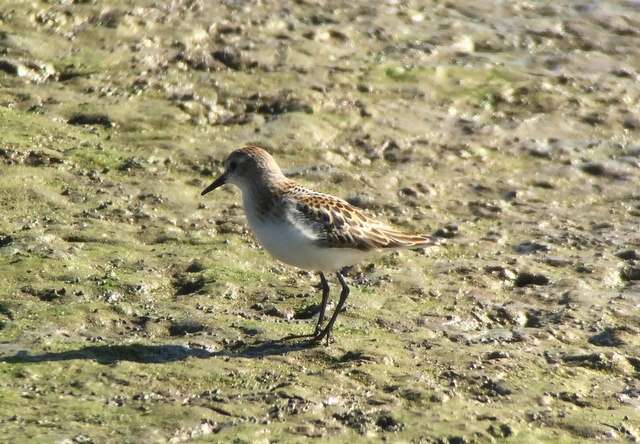 Little Stint – feeding on the mud on the freshmarsh
Little Stint – feeding on the mud on the freshmarsh
While we were watching it, two Curlew Sandpipers flew past, accompanied by another Little Stint and disappeared down behind Island Hide. It rapidly became clear that the Bearded Tits were not going to play ball, so we went to look for the waders. But by the time we got into the hide, they had disappeared too! It really felt like it was going to be one of those days. Finally, after scanning the freshmarsh for a while, the three of them suddenly appeared from round the corner on the edge of the reeds. It was great to watch the two Curlew Sandpipers and one Little Stints, all juveniles, together.
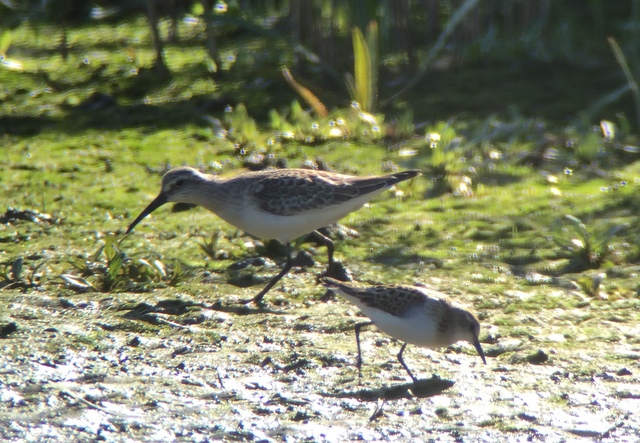 Curlew Sandpiper and Little Stint – showing the size difference
Curlew Sandpiper and Little Stint – showing the size difference
That must have been when our luck changed. While we were watching the waders, a Bearded Tit appeared at the base of the reeds behind them, followed quickly after by another two. One was a smart male, with grey head and black ‘beard’ (more like a moustache). At one point, we had the three waders and the party of Bearded Tits in the scope together! They fed for some time around the base of the reeds, working up and down along the edge of the mud. Finally they climbed up into the reeds, began calling and then flew off back into the reedbed. Cracking birds.
 Bearded Tits – finally gave themselves up for us on the edge of the reeds
Bearded Tits – finally gave themselves up for us on the edge of the reeds
There was a good selection of other waders out on the freshmarsh. A large flock of Bar-tailed Godwit was roosting over high tide, forced off the beach. We spent some time looking at the differences between them and the Black-tailed Godwits nearby. There were small numbers of Dunlin, mostly juveniles, feeding on the edge of the islands. Numbers of Avocet are well down now, from the very high counts of late summer, but there were still several out on the freshmarsh.
There were two Spoonbills on the back of the freshmarsh, doing what Spoonbills like to do best – sleeping. They did wake up occasionally, looking round before tucking their bills back in again. One of them was a juvenile, lacking a yellow tip to its bill. A third Spoonbill flew in from the direction of the saltmarsh and dropped in nearby. A Chinese Water Deer emerged from the reeds along the bank beyond Parrinder Hide.
Back on the main path, we set out towards the beach. The Little Stints kept mostly apart, but briefly joined up with each other as we did and we got great views of them together from the path.
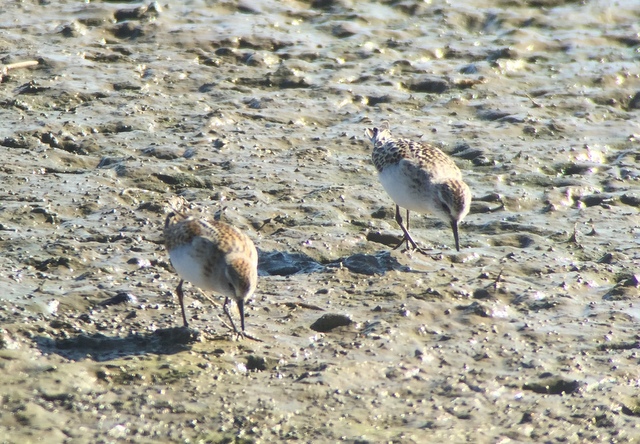 Little Stints – briefly, the two birds fed together
Little Stints – briefly, the two birds fed together
With the tide just going out, Volunteer Marsh was still largely covered with water. There were a few Curlew out amongst the crowds of Redshank. A Little Egret was taking advantage of the tide, looking for food as the water flowed out of the channel over a bank of mud. We watched it running back and forth, chasing prey as it was swept over the shallows.
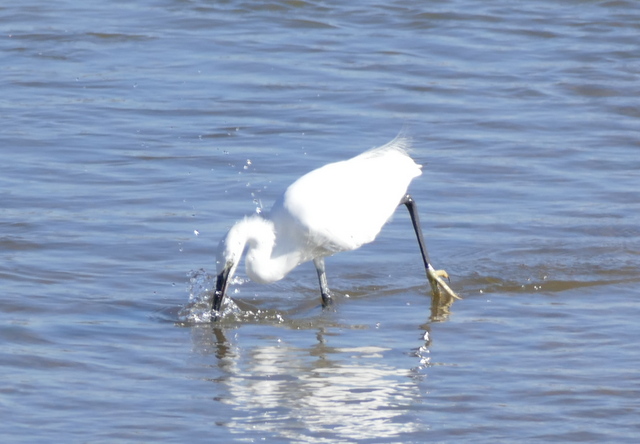 Little Egret – fishing in the shallows on Volunteer Marsh
Little Egret – fishing in the shallows on Volunteer Marsh
There were more waders roosting on the tidal pools – several Grey Plover, more Dunlin and Redshank, and a little group of Turnstone. Some of the Black-tailed Godwits have taken to feeding out here and a couple of them gave really close up views again from the path. They seem to be quite territorial – as well as walking warily round each other, one of them got quite aggressive with one of the Redshank when it attempted to feed nearby.
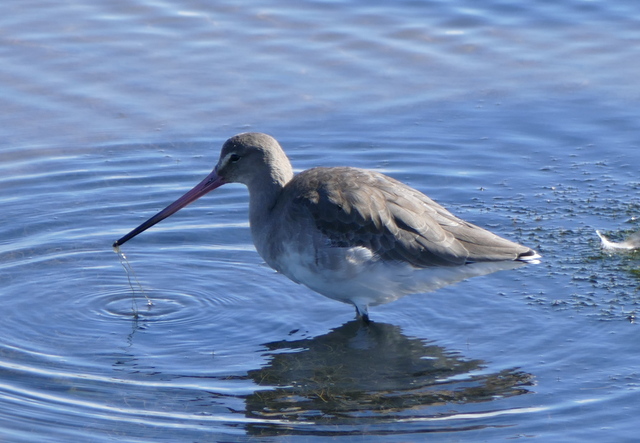 Black-tailed Godwit – showed really well on the tidal pools
Black-tailed Godwit – showed really well on the tidal pools
 Black-tailed Godwit – chasing off one of the Redshank
Black-tailed Godwit – chasing off one of the Redshank
Out on the beach, the tide was still in. Consequently, there were no waders out here today but a party of nine Sanderling flew past among the breakers. There were still quite a few Sandwich Terns fishing offshore and a couple of Gannets flew past. We watched a line of ducks flying in over the sea, which turned out to be nine Shoveler – presumably birds coming in from the continent for the winter. Scanning the sea, we could see several Great Crested Grebes on the water and picked out a couple of Red-throated Divers as well.
We made our way back towards the visitor centre, stopping to scan the pools again as we did so just in case something new had appeared. We had looked for the Spotted Redshanks in their usual place on the way out. Back at the freshmarsh, they had reappeared – ten of them – but they were over the back as usual and mostly asleep. One awoke briefly and preened, flashing its long, needle-fine bill, before tucking it back in again. A Hobby circled high over the back of the freshmarsh, presumably one of the birds we had seen earlier. We could see it catching insects and eating them.
We could hear Bearded Tits calling as we walked past the reedbed and a little crowd had gathered nearby. We stopped and could see why – Bearded Tits in the reeds just below the path. They kept disappearing, but came out again to feed on the seedheads, a pair. Just like buses, we had waited to see one and now we were seeing them everywhere!
 Bearded Tit – feeding in the reeds by the main path
Bearded Tit – feeding in the reeds by the main path
After lunch, we headed back out towards Patsy’s Reedbed and the Autumn Trail. A Bittern (or two) has been showing on and off around here in the last week or so, and one had been seen in flight earlier in the morning, but we didn’t hold out much hope of seeing it ourselves. Still, it is always worth a go. We popped in to Fen Hide for a look, but there was nothing there. Someone in the hide told us that it had been seen ten minutes earlier flying over Patsy’s Reedbed, so we headed straight round there but the trail seemed to have gone cold – there was no sign of it. We did pick up a couple more birds for the day’s tally – a couple of Common Snipe, one sunning itself with tail spread, and a single female Red-crested Pochard.
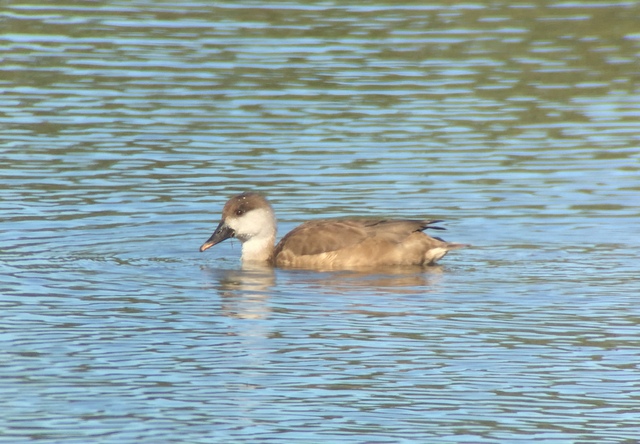 Red-crested Pochard – just the one female around the reserve again today
Red-crested Pochard – just the one female around the reserve again today
Rather than wait indefinitely on the off chance that the Bittern might show itself again, we decided to carry on round to the Autumn Trail. There were lots of dragonflies along the path, Common Darters and Migrant Hawkers. We had not seen any Siskin out over the marshes but they were clearly still passing through – we saw several large flocks of 40-60 pass overhead along the southern edge of the reserve. A Hobby circled out of the trees above us, again presumably one of the young ones we had seen earlier.
 Common Darter – lots still along the Autumn Trail today
Common Darter – lots still along the Autumn Trail today
Round at the end, overlooking the back of the freshmarsh, we could see there were still two Spoonbills. Much closer now, we could see that they were two adults – both with yellow-tipped bills. We had hoped to get a closer look at the Spotted Redshanks, but most of them had disappeared again. The one that was left behind was hard to see behind the reeds. We could hear Bearded Tits calling yet again and a Reed Warbler was flycatching among the reeds.
We made our way back and, as we got to the back of Patsy’s Reedbed, we stopped for a cursory scan. There on the far side, on the edge of the reeds was a Bittern – in full view. We got it in the scopes and got a great look at it. It was working its way along, weaving in and out of the reeds and bulrushes, occasionally pushing its way further in before emerging again further along.
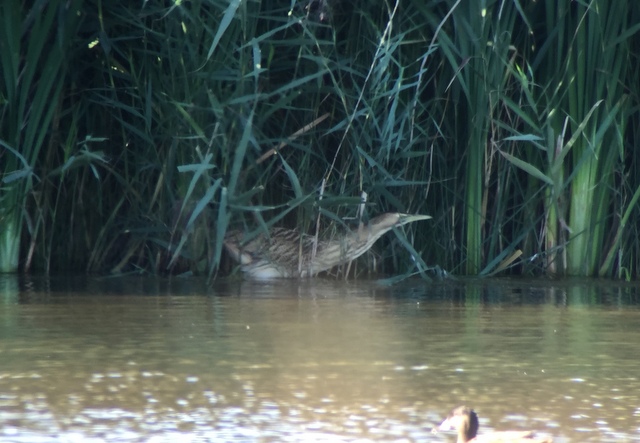 Bittern – working its way along the edge of Patsy’s Reedbed
Bittern – working its way along the edge of Patsy’s Reedbed
We were losing it from view from where we were standing, so we raced back round towards the screen. We stopped again and could see the Bittern still working its way along the reed edge, before it disappeared into the bulrushes out of view. A couple of minutes later it reappeared among the rushes further round. It stretched its neck up, just like every illustration suggests a good Bittern should, and had a good look round. Then it stretched, rearranged its feathers, and took off, flying across the water and disappearing into the reeds at the back of Patsy’s Reedbed. Great views – a real treat to see.
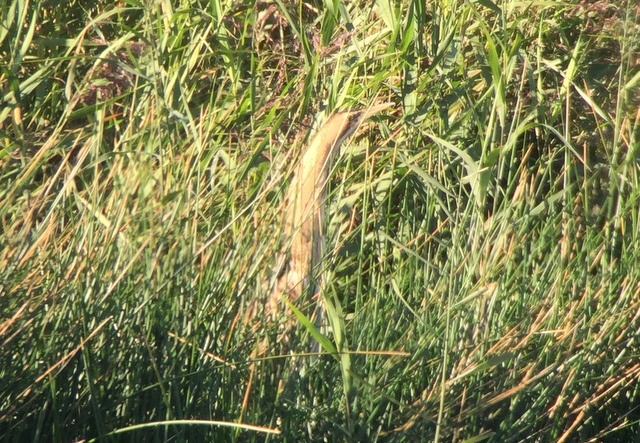 Bittern – stretching its neck up in the rushes
Bittern – stretching its neck up in the rushes
That was a fantastic way to finish, so we headed back towards the car park suitably elated. We made a quick diversion up via Choseley on our way home. There were not many birds around the drying barns, but the fields beyond produced a few Stock Doves, a pair of Grey Partridge as well as countless Red-legged Partridges (ready for the shooting season!) and a number of Brown Hare. Then it was really time to head for home.
















